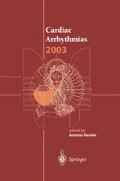Abstract
Present-day pacemaker therapy is not only used to prevent bradycardia or asystole in cases of advanced AV block or sick sinus syndrome. More recent proposed indications for permanent cardiac pacing are the prevention of paroxysmal atrial fibrillation and cardiac resynchronization therapy in patients with heart failure.
Access this chapter
Tax calculation will be finalised at checkout
Purchases are for personal use only
Preview
Unable to display preview. Download preview PDF.
References
Andersen HR, Nielsen JC, Thomsen PEB et al (1997) Long-term follow-up of patients from a randomised trial of atrial versus ventricular pacing for sick sinus syndrome. Lancet 350:1210–1216
Connolly SJ, CR Kerr, M Gent et al (2000) Effects of physiologic pacing versus ventricular pacing on the risk of stroke and death due to cardiovascular causes. N Engl J Med 342:1385–1391
Lamas GA, Lee KL, Sweeney MO et al (2002) Mode selection trial in sinus-node dysfunction ventricular pacing or dual-chamber pacing for sinus-node dysfunction. N Engl J Med 346:1854–1862
Attuel P, Pellerin D, Muciga J, Coumel PH (1988) DDD pacing: an effective treatment modality for recurrent atrial arrhythmias. Pacing Clin Electrophysiol 11:1647–1654
Garrigue S, Barold SS, Cazeau S et al (1998) Prevention of atrial arrhythmias during DDD pacing by atrial overdrive. Pacing Clin Electrophysiol 21:1751–1759
Saksena S, Prakash A, Ziegler P et al, for the DAPPAF Investigators (2002) Improved suppression of recurrent atrial fibrillation with dual-site right atrial pacing and antiarrhythmic drug therapy. J Am Coll Cardiol 40:1140–1150
Carlson MD, Gold MR, Ip J et al, for the ADOPT Investigators (2001) Dynamic atrial overdrive pacing decreases symptomatic atrial arrhythmia burden in patients with sinus node dysfunction. Circulation 104:II-1-II-1088
Beinhauer A, Vock P, Nobis H et al (2001) AF suppression by atrial dynamic overdrive pacing in the ADOPT-ALL trial. P2965. Eur Heart J 22 Abstr Suppl 554
Lee MA, Weachter R, Pollak S et al for the ATTEST Investigators (2003) The effect of atrial pacing therapies on atrial tachyarrhythmias burden and frequency. J Am Coll Cardiol 41:1926–1932
Padeletti L, Purerfellner H, Adler S et al (2002) Atrial septal lead placement and atrial pacing algorithms for prevention of paroxysmal atrial fibrillation: ASPECT study results. NASPE Abstract no 659
Wyse DG, Waldo AL, DiMarco JP et al, The Atrial Fibrillation Follow-up Investigation of Rhythm Management (AFFIRM) Investigators (2002) A comparison of rate control and rhythm control in patients with atrial fibrillation. N Engl J Med 347:1825–1833
Van Gelder IC, Hagens VE, Bosker HA et al, the Rate Control versus Electrical Cardioversion for Persistent Atrial Fibrillation Study Group (2002) Comparison of rate control and rhythm control in patients with recurrent persistent atrial fibrillation. N Engl J Med 347:1834–1840
Author information
Authors and Affiliations
Editor information
Editors and Affiliations
Rights and permissions
Copyright information
© 2004 Springer-Verlag Italia
About this paper
Cite this paper
Schuchert, A. (2004). Atrial Fibrillation Suppression: What Role Does It Have?. In: Raviele, A. (eds) Cardiac Arrhythmias 2003. Springer, Milano. https://doi.org/10.1007/978-88-470-2137-2_18
Download citation
DOI: https://doi.org/10.1007/978-88-470-2137-2_18
Publisher Name: Springer, Milano
Print ISBN: 978-88-470-2177-8
Online ISBN: 978-88-470-2137-2
eBook Packages: Springer Book Archive

